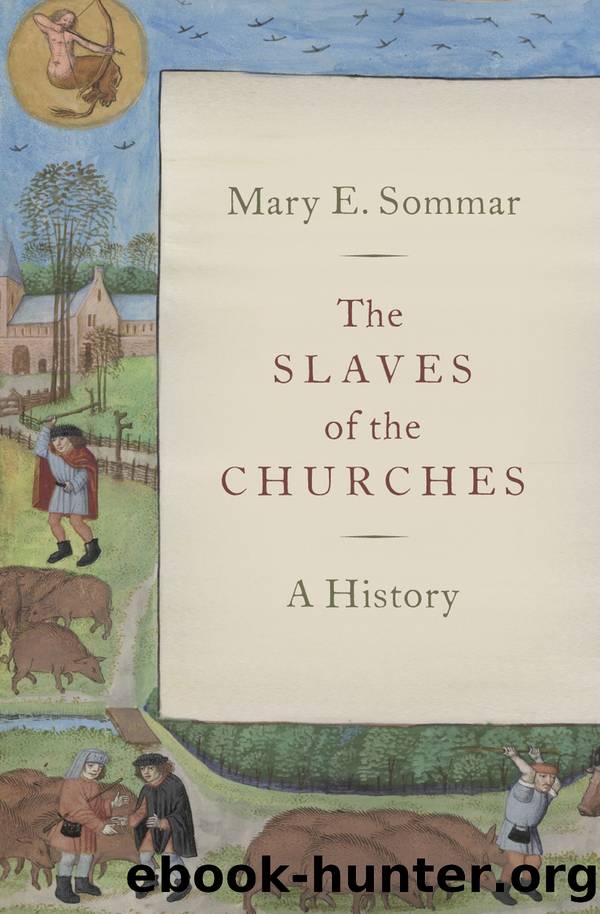The Slaves of the Churches by Mary E. Sommar

Author:Mary E. Sommar
Language: eng
Format: epub
Publisher: Oxford University Press
Published: 2020-11-15T00:00:00+00:00
Canon Law
Visigothic Ecclesiastical Law
There were several councils held by the church in territory occupied by the Visigoths, including the 506 Council of Agde, over which Caesarius of Arles presided.132 Although Agde is geographically in Gaul, at that time the region was under Visigothic control, and the council proceedings show strong Visigothic influence. Canon 7 of this council, according to its heading in a later collection, was concerned with âChurch property: how it is to be held by the bishops and how servi ecclesiae can be set free by a bishop.â133 In short, this canon said that church property could not be alienated by the bishop or other clergy except in cases of grave necessity, and then only with the approval of two or three neighboring bishops. This was in accord with Caesariusâs position as discussed earlier. The canon also stated that if any deserving servi ecclesiae were given their liberty by the bishop, they had to be paid for properly. After such a former church servus died, any property that he had received from the church at the time of his manumission, in excess of stated minimums, had to be returned to the church from which he had been freed.134 The inalienability of church property was reinforced by canon 48, which called for the bishopâs own property to be kept separate from the res ecclesiae, and canon 33, which stated explicitly that the bishopâs family was not to inherit anything that belonged to the church. A number of canons from Agde were concerned with clerical sexual misbehavior. Among the most interesting of these are canon 11, âSlave women or freedwomen are to be removed from the storerooms or from private duties and likewise from any accommodations where a clergyman is stayingâ; and canon 28, requiring that a monasteryâs slave girls be kept well away from the monks.135 From canon 39, which addressed clerical marital relations, we learn that the concern was not merely a question of preventing illicit sexual relations, but also an issue of ritual purity. This canon stated that clergy should not have relations with their wives or even sing love songs, lest the sacred mysteries be âpolluted [by contact with] indecent spectacles or words.â136
The Visigothic church in what is now Spain held a number of general councils, usually under at least the nominal sponsorship of the king, as well as quite a few synods of regional importance. There were also at least eight councils held before the conversion of the Visigoths from Arian to Roman Christianity, but the proceedings of these earliest councils do not yield much information for our purposes.137 But four of the major councils or synods of the Catholic Visigothic kingdomâIII Toledo (589), I Seville (590), IV Toledo (633) and IX Toledo (655)âprovided more than two dozen canons that detailed the special position of servi, ancillae, and liberti ecclesiae. Relevant to our topic, there were an additional dozen or so canons from the remaining synods as well as several passages in Isidore of Sevilleâs Regula monachorum.
Download
This site does not store any files on its server. We only index and link to content provided by other sites. Please contact the content providers to delete copyright contents if any and email us, we'll remove relevant links or contents immediately.
Christian Ethics for a Digital Society by Kate Ott(725)
Fearfully and Wonderfully Made by Philip Yancey & Paul Brand(705)
The World from 1450 To 1700 by Wills John E.;(657)
God and the Multiverse by Victor J. Stenger(616)
Numbers by Ronald B. Allen(578)
How to Read Slowly by James W. Sire(560)
Christian Ethics: An Introduction to Biblical Moral Reasoning by Wayne Grudem(559)
Morality by Jonathan Sacks(511)
Monastic Archaeology by Unknown(494)
The Technological System by Jacques Ellul(482)
The Disabled Church by Rebecca F. Spurrier;(470)
Jesus: A New Vision by Whitley Strieber(468)
Amish Grace by Donald B. Kraybill & Nolt Steven M. & Weaver-Zercher David L(466)
Children of Lucifer; The Origins of Modern Religious Satanism by Ruben van Luijk(458)
Death of the Doctor by Unknown(452)
Critical Writings by Joyce James;(450)
Redeeming Sociology by Vern S. Poythress(444)
The City of God by Saint Augustine & Marcus Dods(442)
The Church in the Early Middle Ages by G.R. Evans(421)
